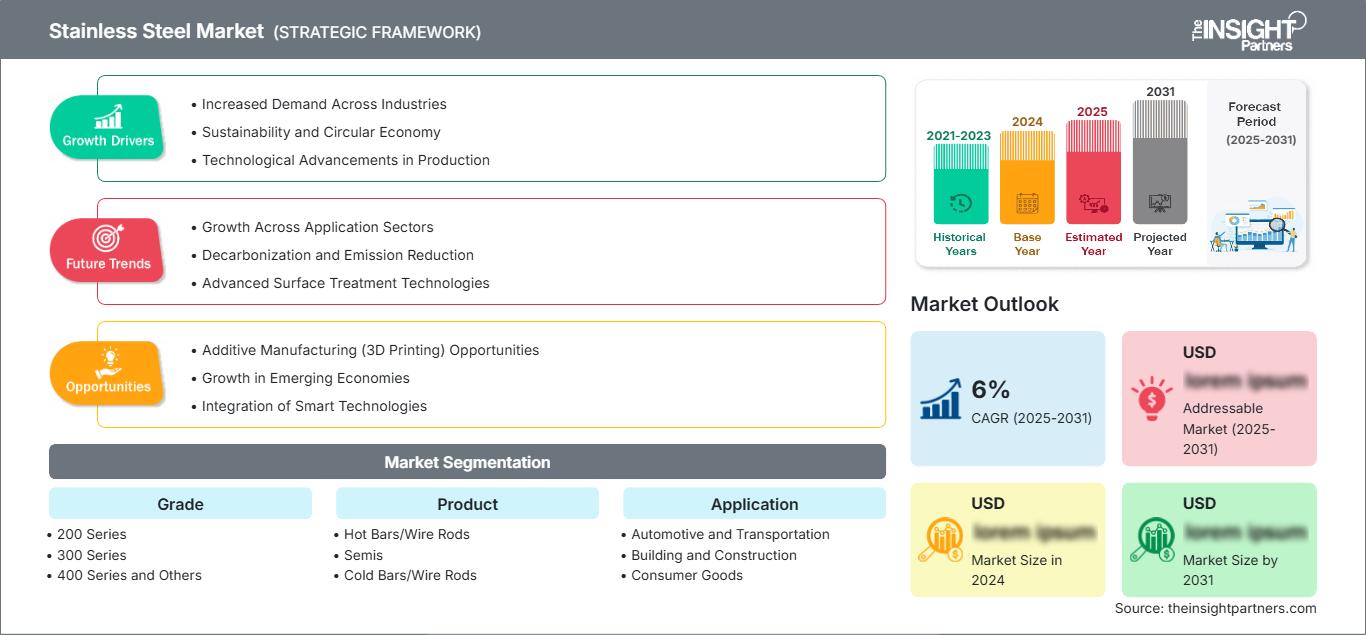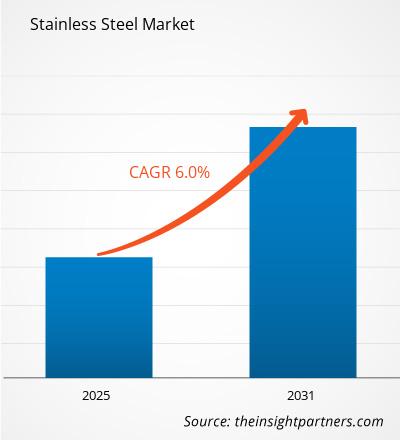Der Markt für Edelstahl wird bis 2031 voraussichtlich ein Volumen von 173,48 Milliarden US-Dollar erreichen. Für den Zeitraum 2025–2031 wird ein jährliches Wachstum von 2,7 % erwartet.
Der Bericht ist nach Güteklassen (200er-Serie, 300er-Serie, 400er-Serie und andere) und Produktarten (Warmstahl/Walzdraht, Halbzeuge, Kaltstahl/Walzdraht, Warmband, Warmbleche und -platten sowie kaltgewalztes Flachstahl) segmentiert. Darüber hinaus enthält der Bericht Analysen basierend auf den Anwendungsbereichen (Automobilindustrie und Transportwesen, Bauwesen, Konsumgüter, Schwerindustrie, Elektromaschinen und andere). Die globale Analyse wird weiter auf regionaler Ebene und für wichtige Länder aufgeschlüsselt. Marktgröße und Prognosen auf globaler, regionaler und Länderebene für alle wichtigen Marktsegmente sind im Bericht enthalten. Die Werte für die oben genannten Analysen und Segmente werden in US-Dollar angegeben. Der Bericht liefert wichtige Statistiken zum Marktstatus der wichtigsten Marktteilnehmer und bietet Einblicke in Markttrends und -chancen.
Zweck des Berichts
Der Bericht „Edelstahlmarkt“ von The Insight Partners beschreibt die aktuelle Marktlage und das zukünftige Wachstum, die wichtigsten Triebkräfte, Herausforderungen und Chancen. Er bietet Einblicke für verschiedene Interessengruppen, wie zum Beispiel:
- Technologieanbieter/Hersteller: Um die sich entwickelnde Marktdynamik zu verstehen und potenzielle Wachstumschancen zu erkennen, können sie fundierte strategische Entscheidungen treffen.
- Investoren: Um eine umfassende Trendanalyse hinsichtlich Marktwachstumsrate, Finanzprognosen und Chancen entlang der Wertschöpfungskette durchzuführen.
- Regulierungsbehörden: Um Richtlinien zu regulieren und Aktivitäten auf dem Markt zu überwachen, mit dem Ziel, Missbrauch zu minimieren, das Vertrauen der Investoren zu wahren und die Integrität und Stabilität des Marktes zu gewährleisten.
Marktsegmentierung für Edelstahl nach Güteklasse
- 200er-Serie
- 300er-Serie
- 400er-Serie und andere
Produkt
- Warmstahl/Walzdraht
- Halbzeug
- Kaltstahl/Walzdraht
- Warmcoils
- Warmbleche und -platten sowie kaltgewalzte Flachstähle
Anwendung
- Automobil- und Transportwesen
- Bauwesen
- Konsumgüter
- Schwerindustrie
- Elektromaschinen und andere
Geografie
- Nordamerika
- Europa
- Asien-Pazifik
- Süd- und Mittelamerika
- Naher Osten und Afrika
Sie erhalten kostenlos Anpassungen an jedem Bericht, einschließlich Teilen dieses Berichts oder einer Analyse auf Länderebene, eines Excel-Datenpakets sowie tolle Angebote und Rabatte für Start-ups und Universitäten.
Edelstahlmarkt: Strategische Einblicke

-
Holen Sie sich die wichtigsten Markttrends aus diesem Bericht.Dieses KOSTENLOSE Beispiel umfasst Datenanalysen, die von Markttrends bis hin zu Schätzungen und Prognosen reichen.
Wachstumstreiber des Edelstahlmarktes
- Gesteigerte Nachfrage in verschiedenen Branchen: Der zunehmende Verbrauch von Edelstahl in verschiedenen Endverbraucherbranchen wie dem Bauwesen, der Automobilindustrie und der Konsumgüterindustrie hat sich als bedeutender Wachstumstreiber für den Edelstahlmarkt erwiesen. Insbesondere der Bausektor verzeichnet aufgrund der Urbanisierung und des Infrastrukturausbaus ein vielversprechendes Wachstum, da dadurch immer mehr Edelstahl für Konstruktionen, Dächer und Fassaden benötigt wird. Auch die Automobilindustrie profitiert von Edelstahl aufgrund seiner Langlebigkeit und Korrosionsbeständigkeit, was letztendlich die Lebensdauer und Leistungsfähigkeit der Fahrzeuge erhöht.
- Nachhaltigkeit und Kreislaufwirtschaft: Alle Branchen sind zunehmend bestrebt, die Normen der nachhaltigen Entwicklung einzuhalten, und Hersteller setzen verstärkt auf umweltfreundliche Verfahren. Edelstahl ermöglicht die Wiederverwendung von Materialien und ist somit Teil der globalen Abfallvermeidungsagenda und trägt zur Wertschöpfungskette der Kreislaufwirtschaft bei. Mit zunehmender Regulierung und strengeren Normen hinsichtlich Emissionen und Materialeinsatz werden die Industrien weiterhin auf nachhaltige Alternativen wie Edelstahl umsteigen und dadurch den Verbrauch steigern.
- Technologische Fortschritte in der Produktion: Verbesserte Schmelz- und Raffinationsprozesse sowie neuere Fertigungstechnologien erhöhen die Effizienz und Qualität der Edelstahlherstellung. Beispielsweise hat die Elektrolichtbogenofen-Technologie (EAF) die Produktionsmethoden nachhaltiger gestaltet, da sie einen geringeren Energiebedarf und niedrigere Emissionen bei der Stahlproduktion ermöglicht. Dies hat die Produktionskosten gesenkt und die Produktqualität verbessert, wodurch die Produkte für Endverbraucher wertvoller geworden sind.
Zukunftstrends des Edelstahlmarktes
- Wachstum in verschiedenen Anwendungsbereichen: Der Einsatz von Edelstahl in der Industrie hat stark zugenommen. Dies ist auf die bereits erwähnten Eigenschaften wie Korrosionsbeständigkeit, Festigkeit und Ästhetik zurückzuführen. Diese Eigenschaften führen zu einem breiteren Einsatz in Branchen wie dem Bauwesen, der Automobilindustrie, der Lebensmittelverarbeitung und der Konsumgüterindustrie, wo Langlebigkeit, Sicherheit und Ästhetik eine wichtige Rolle spielen. Dekarbonisierung und Emissionsreduzierung: Der Druck auf die Stahlindustrie, ihre CO₂-Emissionen zu reduzieren, steigt mit der Dekarbonisierung und Emissionsreduzierung in der Produktion. Unternehmen erforschen neue Wege, um ihre Emissionen bei der Edelstahlproduktion zu senken, darunter die Nutzung erneuerbarer Energien und die Installation von CO₂-Abscheidungstechnologien. Dies entspricht nicht nur gesetzlichen Vorgaben, sondern auch den Erwartungen der Verbraucher an umweltfreundliche Produkte. Fortschrittliche Oberflächenbehandlungstechnologien: Elektropolieren und andere fortschrittliche Oberflächenbehandlungstechnologien gewinnen zunehmend an Bedeutung, um die Leistung und Ästhetik von Edelstahlprodukten zu verbessern. Verbesserte Korrosionsbeständigkeit, Oberflächengüte und Ästhetik machen Edelstahl zu einer attraktiven Option für die Lebensmittelverarbeitung, die Pharmaindustrie und hochwertige Konsumgüter. Dieser Trend spiegelt das Engagement der Branche für Qualität und Leistung wider. Marktchancen für Edelstahl: Die Einführung der additiven Fertigung (3D-Druck) eröffnet der Edelstahlindustrie enorme Chancen. Die Technologie zeichnet sich durch die Herstellung einzigartiger Geometrien und komplexer, kundenspezifischer Bauteile nach langjähriger Anwendung traditioneller Fertigungstechniken aus. Da die Industrie nach produktiveren und flexibleren Produktionsmethoden sucht, kann sie mit Edelstahl neue Anwendungsbereiche und Marktnischen erschließen.
- Wachstum in Schwellenländern: Die Schwellenländer schreiten rasant in Richtung Industrialisierung und Urbanisierung voran und bieten damit attraktive Chancen für Edelstahlhersteller. Mit dem Wachstum und der Weiterentwicklung dieser Märkte werden sich die Konsummuster entsprechend verändern, und die Nachfrage nach Edelstahl im Bauwesen, in der Automobilindustrie und bei Konsumgütern wird stark steigen. Unternehmen, die sich in diesen Bereichen bereits etabliert haben, können von diesem Boom profitieren und sich einen beträchtlichen Marktanteil sichern.
- Integration intelligenter Technologien: Intelligente Technologien wie IoT und KI lassen sich in die Produktionsprozesse von Edelstahl integrieren. Ihre Anwendung wird die Abläufe optimieren und die Produktqualität verbessern. Hersteller werden ihre Produktionslinien mithilfe von Datenanalysen, Abfallminimierung und verbessertem Lieferkettenmanagement optimieren. Diese Prozesstechnologieverbesserung wird durch kürzere Lieferzeiten zu höherer Produktivität und einer besseren Reaktionsfähigkeit auf Marktnachfrage und Verbraucherpräferenzen führen.
Edelstahlmarkt
Die regionalen Trends und Einflussfaktoren auf den Edelstahlmarkt im gesamten Prognosezeitraum wurden von den Analysten von The Insight Partners ausführlich erläutert. Dieser Abschnitt behandelt außerdem die Marktsegmente und die geografische Verteilung des Marktes für das Management von Herzrhythmusstörungen in Nordamerika, Europa, Asien-Pazifik, dem Nahen Osten und Afrika sowie Süd- und Mittelamerika.
Umfang des Marktberichts zu Edelstahl
| Berichtsattribut | Einzelheiten |
|---|---|
| Marktgröße in 2024 | US$ XX Billion |
| Marktgröße nach 2031 | US$ 173.48 Billion |
| Globale CAGR (2025 - 2031) | 2.7% |
| Historische Daten | 2021-2023 |
| Prognosezeitraum | 2025-2031 |
| Abgedeckte Segmente |
By Klasse
|
| Abgedeckte Regionen und Länder |
Nordamerika
|
| Marktführer und wichtige Unternehmensprofile |
|
Dichte der Akteure im Edelstahlmarkt: Auswirkungen auf die Geschäftsdynamik
Der Markt für Edelstahl wächst rasant, angetrieben durch die steigende Nachfrage der Endverbraucher. Gründe hierfür sind unter anderem sich wandelnde Verbraucherpräferenzen, technologische Fortschritte und ein wachsendes Bewusstsein für die Vorteile des Produkts. Mit steigender Nachfrage erweitern Unternehmen ihr Angebot, entwickeln innovative Lösungen, um den Verbraucherbedürfnissen gerecht zu werden, und nutzen neue Trends, was das Marktwachstum zusätzlich beflügelt.

- Holen Sie sich die Edelstahlmarkt Übersicht der wichtigsten Akteure
Wichtigste Verkaufsargumente
- Umfassende Abdeckung: Der Bericht bietet eine umfassende Analyse der Produkte, Dienstleistungen, Typen und Endnutzer des Edelstahlmarktes und vermittelt so ein ganzheitliches Bild.
- Expertenanalyse: Der Bericht basiert auf dem fundierten Wissen von Branchenexperten und Analysten.
- Aktuelle Informationen: Der Bericht gewährleistet Geschäftsrelevanz durch die Berücksichtigung aktueller Informationen und Datentrends.
- Anpassungsmöglichkeiten: Dieser Bericht kann an spezifische Kundenanforderungen angepasst werden und sich optimal in die Geschäftsstrategien integrieren.
Der Forschungsbericht zum Edelstahlmarkt kann somit maßgeblich dazu beitragen, das Branchenszenario und die Wachstumsaussichten zu entschlüsseln und zu verstehen. Auch wenn einige berechtigte Bedenken bestehen, überwiegen die Vorteile dieses Berichts in der Regel die Nachteile.
- Historische Analyse (2 Jahre), Basisjahr, Prognose (7 Jahre) mit CAGR
- PEST- und SWOT-Analyse
- Marktgröße Wert/Volumen – Global, Regional, Land
- Branchen- und Wettbewerbslandschaft
- Excel-Datensatz
Aktuelle Berichte
Erfahrungsberichte
Grund zum Kauf
- Fundierte Entscheidungsfindung
- Marktdynamik verstehen
- Wettbewerbsanalyse
- Kundeneinblicke
- Marktprognosen
- Risikominimierung
- Strategische Planung
- Investitionsbegründung
- Identifizierung neuer Märkte
- Verbesserung von Marketingstrategien
- Steigerung der Betriebseffizienz
- Anpassung an regulatorische Trends






















 Kostenlose Probe anfordern für - Edelstahlmarkt
Kostenlose Probe anfordern für - Edelstahlmarkt